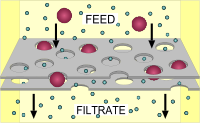
Photo from wikipedia
Abstract Oily wastewater has become a serious environmental problem and attracted global concern. Traditional methods are limited by their low separation efficiency, complicated instrument setup and high energy usage. Therefore,… Click to show full abstract
Abstract Oily wastewater has become a serious environmental problem and attracted global concern. Traditional methods are limited by their low separation efficiency, complicated instrument setup and high energy usage. Therefore, it is imperative to develop cost-effective materials or technologies for treating emulsified oil wastewaters. In this study, the expanded perlite (EP) was firstly modified by 3-aminopropyl triethoxysilane (APTES) to form the EP@APTES, and then magnetic Fe3O4 nanoparticles (NPs) were further grafted onto the surface of EP@APTES to synthesize the novel composite of EP@APTES-Fe3O4. The synthesized EP@APTES-Fe3O4 was employed as an environmentally friendly and recyclable demulsifier for treating emulsified oil wastewaters and its demulsification performance was evaluated. Especially, the effects of pH, demulsifier dosage and salt concentration on oil separation efficiency have been studied detailedly. The demulsification mechanism was also explored. Results showed that synthetic EP@APTES-Fe3O4 has favorable demulsification performance. The oil absorbance in the aqueous phase decreased to the lowest value when 500 mg/L of EP@APTES-Fe3O4 was added into the emulsified wastewaters. Besides, the demulsification efficiency has little difference at different salt concentrations, suggesting the favorable salt resistance of EP@APTES-Fe3O4. What’s more, the EP@APTES-Fe3O4 can be recycled up to 4 cycles without showing significant decrease in emulsion separation efficiency, which can be ascribed to the facts that the EP@APTES-Fe3O4 has good amphiphilicity and can reach the oil-water interface to contact the molecules of asphaltenes and resins; besides, it was positively charged under the conditions of pH 2.0, 4.0 and 6.0, and oil droplets could be effectively attached to the EP@APTES-Fe3O4 via electrostatic attraction. In conclusion, EP@APTES-Fe3O4 can be easily synthesized and recycled, providing a promising and cost-effective demulsifies to remove oil from the emulsified oil wastewater.
Journal Title: Chemical Engineering Journal
Year Published: 2018
Link to full text (if available)
Share on Social Media: Sign Up to like & get
recommendations!